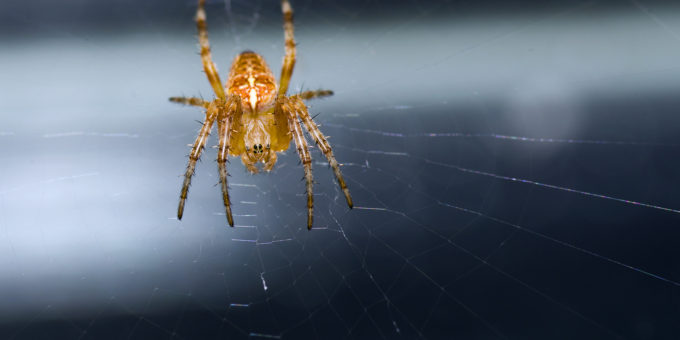Tag: garden spider
Garden full of Spiders – The Orb Weavers
Around this time of year the garden fills with these little Orb Weavers Araneus diadematus. These little spiders are first seen in the spring in little clusters of the tiny spiders holding together in a ball for survival. But as late August roles around these spiders start to get to their largest sizes and fill the yard and garden with their many webs.
Orb weavers come in many types but the ones I see in my yard are sometimes called European Garden spiders ( Also found in North America) or Cross spiders. This little Orb Weaver is harmless to people being docile and not interested in biting unless provoked. It is however a veracious predator in the garden consuming a large variety of insects throughout the spring summer and fall. August and September seem to be the months when the most variety of prey is taken as this is when the spiders are at their largest and most able to take down more powerful opponents. I have witnessed these spiders taking down yellow jacket wasps on occasion using their web to quickly subdue the formidable prey.

Spider Mating a Dangerous Affair
At this stage in the season these spiders also seem to be looking for mates. Mating in this species is a dangerous affair for the male. You can sometimes witness the male spider approaching the much larger females while tapping on her web cautiously. If things go wrong, the male is often made into a meal before it has a chance to successfully mate.
These Orb Weavers as the name indicates create beautiful orb shaped webs. They construct and take back down these webs on a regular basis. When the webbing is taken down either by accident or by the spider itself these spiders will often then consume the webbing to recycle it.
It is hard to miss these spiders this time of year in my yard. It is a constant battle not to accidentally walk into their webs. But they are fascinating and important part of the garden and really worth respect and admiration.

Spider Living by a Wasp Nest Front Door
This could be the original odd couple . Back on July 1st I tweeted about this strange living relationship between this garden spider and this nest of wasps. These two species had been living seemingly peacefully for almost two weeks at the point of my first tweet.
This little #spider set up shop close to some rather formidable neighbours with this yellow jacket nest. But so far they seem to be coexisting peacefully for almost 2 weeks now. pic.twitter.com/OINvKKxbNp
— CoolCreepyCritters (@CoolCcritters) July 1, 2018
Several days later they were still apparently friendly
So far still being friends! @LocalWaspGuy pic.twitter.com/gwqFLGEzw9
— CoolCreepyCritters (@CoolCcritters) July 4, 2018
A few days ago I checked the location again and to my disappointment I did not see the spider. Yellow Jacket Wasps are powerful warriors and formidable predators. While as adults they tend to consume primarily carbohydrates with sugar rich foods like fruits and tree sap. However they do also collect meats which they feed to their young larva. Spiders in turn do sometimes prey on wasps if the spider is large enough and the wasp is adequately subdued in the spiders web.
This morning I decided to have another look, and low and behold , they are sill living side by side (see top image). The spider looks quite healthy and seems to have put on size since the first photos. It makes me wonder if the disappearance of the spider was perhaps due to it molting.
Both spiders and wasps are considered very beneficial to humans as both remove a large amount of pest insects and so are important for agriculture. Bees have gotten a lot of good press in recent years about how important they are in pollination and while this is great, many other species also deserve a more positive spotlight.
Garden Spider Mating Goes Very Wrong
This encounter of two garden spiders happened as I left my house. I grabbed my camera and filmed the two spiders in what appeared to be courtship.
These spiders are docile and harmless to people. I like to see them in my garden as they take out a lot of the flying insects such as misquotes and wasps.
It is fairly interesting to see the male attempt to wrap the legs of the much larger and aggressive female with its web. Ultimately the female was not interested and the male paid the price.
This is a fairly common scenario with this Cross Orb Weaver; apparently love really does hurt when you are a male garden spider.


